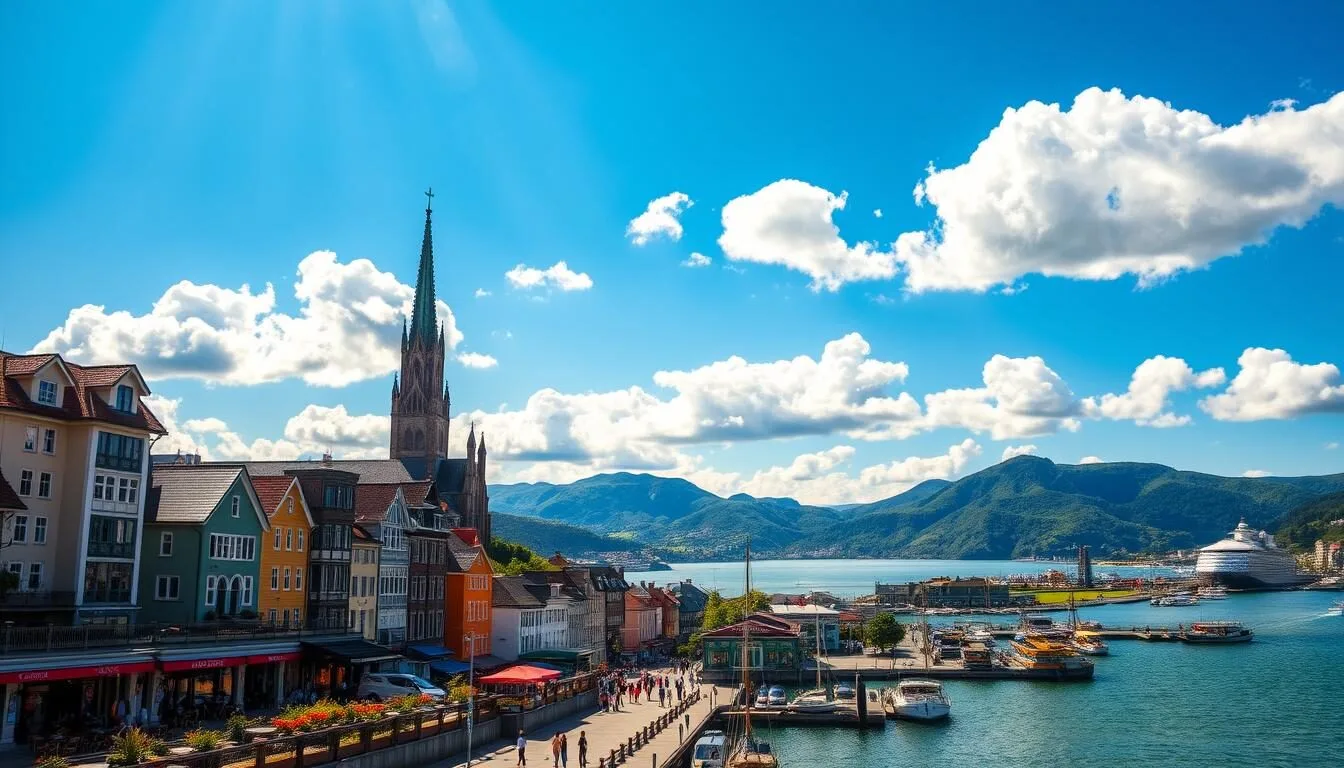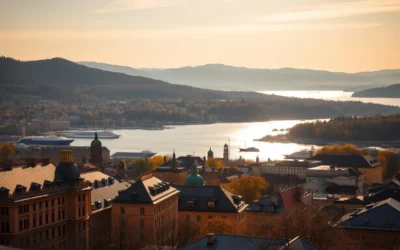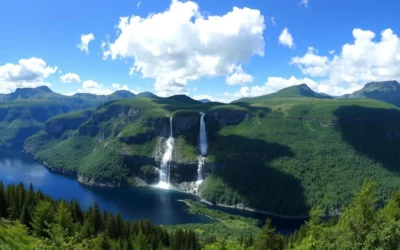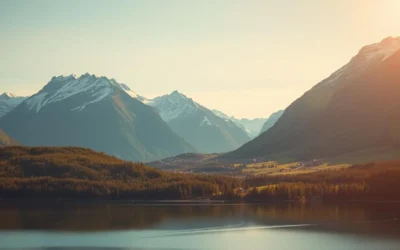✓ Accommodations✓ Flights✓ Rental Cars
Imagine a city where the rugged beauty of nature meets the richness of history and culture. Stavanger is that place, offering an unforgettable experience for travelers.
As you plan your trip, you’ll find that this charming coastal city is more than just a day trip destination. It’s a gateway to Norway’s most spectacular landscapes and a city with a fascinating journey from Viking settlement to oil capital.
This comprehensive guide will walk you through the top things to do in Stavanger, from its historic old town to hiking the famous Pulpit Rock. Get ready to explore and discover why Stavanger is a must-visit destination.
Discovering Stavanger: Norway’s Charming Coastal City
Nestled on Norway’s southwestern coast, Stavanger is a city that seamlessly merges its rich history with contemporary charm. As the oil capital of Norway, it offers a unique blend of modern industry and historical character, making it an exciting place to visit.
Stavanger’s compact size makes it easy to explore on foot, allowing you to experience the best things the city has to offer in a short amount of time. Its proximity to stunning natural landscapes, including the famous Lysefjord, makes it an ideal base for travelers looking to explore the surrounding area.
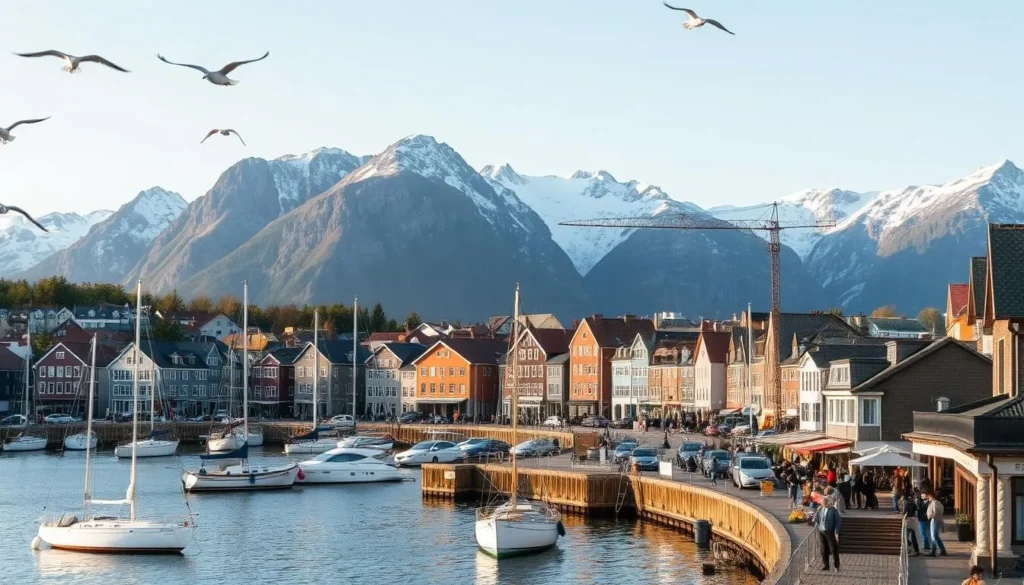
The city’s vibrant atmosphere is a result of its international population, drawn by the oil industry, creating a cosmopolitan feel in this traditional Norwegian setting. You can enjoy a variety of cultural experiences, outdoor adventures, or culinary explorations, as Stavanger offers something for every type of traveler.
| Experience | Description |
|---|---|
| Cultural Heritage | Explore Stavanger’s rich history through its well-preserved wooden buildings and cobblestone streets. |
| Outdoor Activities | Hike, kayak, or take a boat tour to experience the breathtaking natural beauty surrounding Stavanger. |
| Culinary Delights | Savor traditional Norwegian cuisine and modern culinary innovations in Stavanger’s restaurants and cafes. |
Whether you’re interested in history, nature, or cuisine, Stavanger is a fascinating destination that promises an unforgettable experience.
A Brief History of Stavanger: From Viking Roots to Oil Capital
As you explore Stavanger, Norway, you’ll uncover a rich history that spans over a thousand years. The city’s story is deeply intertwined with its Viking roots, its role as the “canning capital of Norway,” and its current status as Norway’s oil capital.
Viking Heritage
Stavanger’s history began with the Vikings, who settled in the area and made it an important hub. The nearby Hafrsfjord was the site of a pivotal battle in 872 AD, where King Harald Fairhair unified Norway under one crown. This momentous event is commemorated by the Sverd i Fjell monument, symbolizing the city’s Viking heritage. The construction of Stavanger Cathedral in 1125 further solidified the city’s importance during the medieval period.
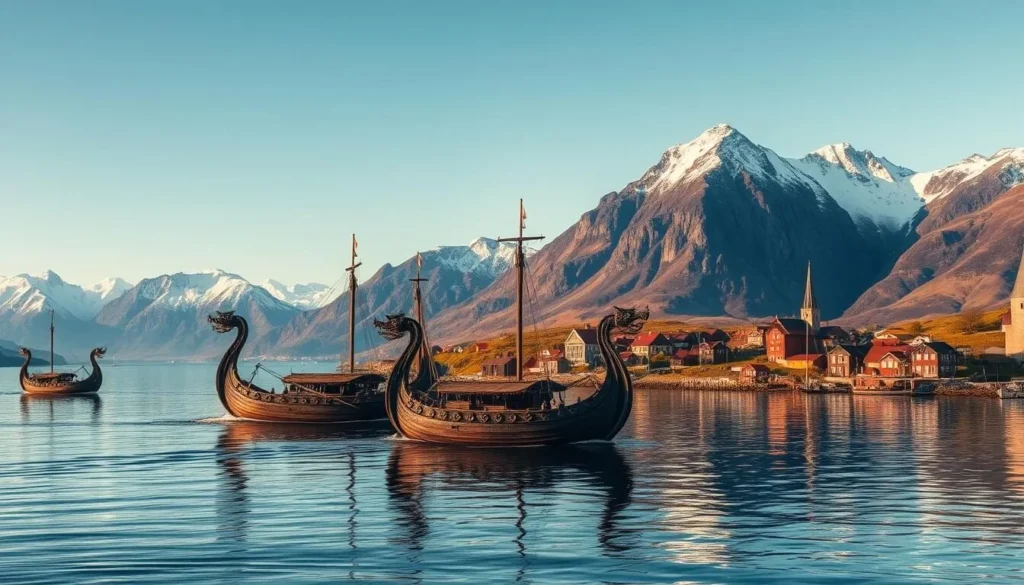
The Canning Era
In the 19th and early 20th centuries, Stavanger transformed into the “canning capital of Norway,” with numerous factories processing and exporting fish, particularly sardines, worldwide. The canning industry employed a significant portion of the city’s population and shaped its development. Many of the wooden houses in Gamle Stavanger were originally built for workers from the sardine factories, reflecting the industry’s impact on the city’s architecture and social fabric.
The Oil Boom
The discovery of oil in the North Sea in 1969 marked a new era for Stavanger, catapulting it to the status of Norway’s oil capital. The oil boom brought unprecedented wealth and international influence to the city, attracting workers from around the world and transforming Stavanger into the cosmopolitan hub it is today. The economic transformation enabled Norway to build one of the world’s largest sovereign wealth funds, ensuring the benefits of oil extend far beyond the industry itself.
| Era | Significant Events | Impact on Stavanger |
|---|---|---|
| Viking Age | Battle of Hafrsfjord, 872 AD | Established as an important settlement |
| Canning Era | Factories processing and exporting fish | Transformed into “canning capital of Norway” |
| Oil Boom | Discovery of oil in the North Sea, 1969 | Became Norway’s oil capital, cosmopolitan hub |
Exploring Gamle Stavanger: The Historic Old Town
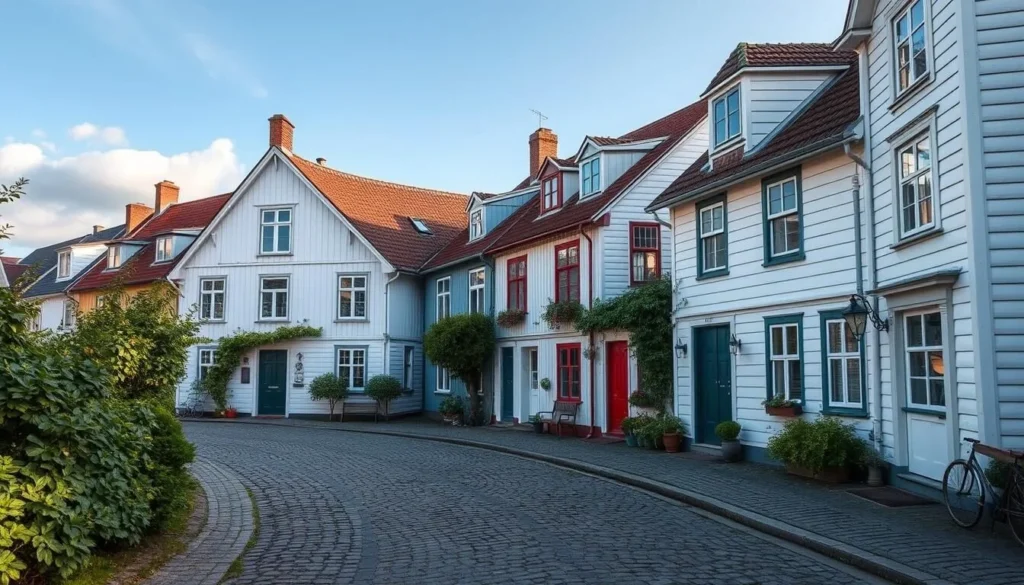
Gamle Stavanger, the historic old town, is a treasure trove of 18th-century white wooden houses that will transport you back in time. This charming district is home to 173 meticulously preserved buildings, decorated with flowers in the summer, creating a picturesque landscape.
As you stroll through its cobblestone streets, you’ll feel like time has stopped. The area’s history is deeply tied to the canning industry, with many houses originally owned by workers from the sardine factories. Today, Gamle Stavanger is one of the best-preserved wooden house settlements in Europe.
Key Highlights:
- Gamle Stavanger (Old Town) features 173 meticulously maintained white wooden buildings from the 18th and 19th centuries.
- The narrow cobblestone streets transport you back in time, with each house telling its own story of Stavanger’s maritime and industrial past.
- The area was once home to sailors, craftsmen, and workers from the city’s thriving canning industry.
- Many charming wooden houses now contain boutique shops, art galleries, and craft studios showcasing local artisans’ work.
- Visit early in the morning or late afternoon to avoid crowds and capture perfect photos.
- Pay attention to the colorful doors and window frames that add character to the otherwise uniformly white facades.
Gamle Stavanger’s location near the harbor makes it an ideal starting point for your exploration of the city. You can easily combine your visit here with other attractions, making the most of your time in Stavanger.
Fargegaten: Stavanger’s Vibrant Colorful Street
As you wander through Stavanger, you’ll discover Fargegaten, a street that embodies the city‘s vibrant spirit. Fargegaten, or “Color Street,” is a kaleidoscope of colors that will captivate your senses. This iconic colorful street is a must-visit destination that will leave you spellbound with its charm.
Shopping and Cafes
Fargegaten offers a delightful collection of unique boutiques, cozy cafés, and art galleries, making it the perfect place to shop for one-of-a-kind souvenirs or enjoy a relaxing coffee break. You can find everything from vintage clothing to handcrafted Norwegian goods, providing an alternative to mainstream retail. The cafés along this vibrant street offer excellent opportunities to people-watch while sampling local pastries and specialty coffees.
Best Photo Spots
Photography lovers will find endless inspiration on Fargegaten, with the best photo spots including the central intersection where you can capture the full rainbow effect of buildings lining both sides of the street. Visit during different times of day to experience how the changing light transforms the vibrant facades—morning light creates a soft glow, while evening light intensifies the colors.
| Time of Day | Effect on Colors |
|---|---|
| Morning | Soft Glow |
| Evening | Intensified Colors |
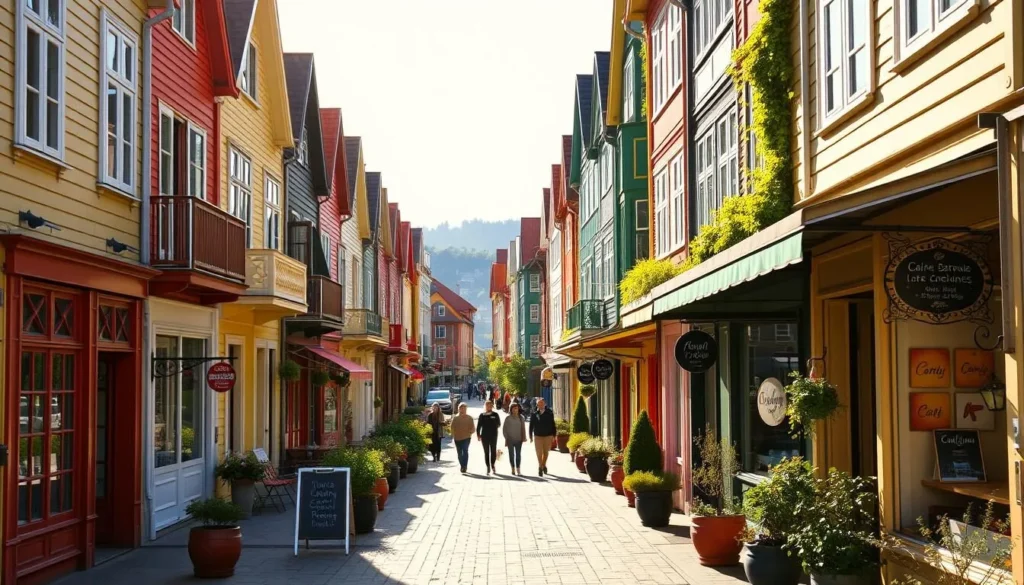
Must-Visit Museums in Stavanger
With a history that spans from Viking times to the present day, Stavanger’s museums are a must-visit. As you explore the city, you’ll discover that its prosperity is rooted in its rich cultural heritage and significant historical events.
Norwegian Petroleum Museum
The Norwegian Petroleum Museum stands out as one of Stavanger’s most visited attractions. It offers an interactive exploration of how the discovery of oil transformed both Stavanger and Norway. Inside, you can try on survival suits, experience simulated life on an oil rig, and learn about Norway’s approach to sustainable energy for the future.

Norwegian Canning Museum
The Norwegian Canning Museum provides a unique look at Stavanger’s former life as the “canning capital of Norway.” Housed in an authentically preserved sardine canning factory, the museum offers live demonstrations of the traditional canning process. You can even sample freshly smoked sprats on certain days during summer, making it a delightful experience.

Museum of Archaeology
The Museum of Archaeology takes you further back in time, showcasing Viking artifacts and prehistoric treasures that tell the story of human settlement in the region. It’s a fascinating journey through the ages, providing insights into the lives of the people who once inhabited this area.

These museums collectively offer a comprehensive understanding of Stavanger’s evolution from a Viking settlement to a fishing town and finally to a modern oil capital. Allow at least 2-3 hours for each museum visit to fully appreciate the detailed exhibits and interactive experiences they offer.
Stavanger, Norway: Best Things to Do for Nature Lovers
Stavanger, Norway, is a paradise for nature lovers, offering a diverse range of landscapes and activities that cater to all interests. From the majestic fjords to the serene gardens, Stavanger is a haven for those who appreciate the beauty of the natural world.
Lysefjord and Its Natural Beauty
The Lysefjord is one of Norway’s most spectacular natural attractions, and a must-visit when in Stavanger. This fjord is a marvel of nature, with steep cliffs rising dramatically from the water. Visitors can take a boat tour to explore the fjord’s many wonders, including the famous Preikestolen (Pulpit Rock), a flat-topped cliff that offers breathtaking views. The area is also home to a variety of wildlife, including birds and fish, making it a haven for nature enthusiasts.
| Attraction | Location | Description |
|---|---|---|
| Preikestolen | Forsand, Norway | A flat-topped cliff with breathtaking views |
| Lysefjord | Stavanger, Norway | A fjord with steep cliffs and crystal-clear water |
Urban Oases: Parks and Gardens in Stavanger
For those who prefer a more relaxed pace, Stavanger’s parks and gardens offer a serene escape from the hustle and bustle of city life. The city’s parks are meticulously maintained, featuring beautiful flora and fauna. Visitors can stroll through the gardens, take in the sights and sounds of nature, and enjoy the peaceful atmosphere.
The city’s commitment to preserving green spaces is evident in its many parks and gardens, which provide a tranquil oasis in the heart of the city. Whether you’re looking to relax, exercise, or simply enjoy the outdoors, Stavanger’s parks and gardens have something to offer.
By exploring Stavanger’s natural beauty, visitors can experience the best of what the city has to offer. From the majestic fjords to the serene gardens, there’s something for everyone in this charming Norwegian city.
Hiking Pulpit Rock (Preikestolen): Essential Guide

Pulpit Rock, or Preikestolen, is a must-visit destination for any traveler to Stavanger, offering breathtaking views of Lysefjord. This iconic flat-topped cliff rises 604 meters above the fjord, making it a thrilling adventure for those who hike there.
Trail Difficulty and Preparation
The hike to Pulpit Rock is approximately 8 kilometers round trip and typically takes 4-5 hours to complete. While it’s considered a moderate hike, the trail includes steep sections and uneven terrain, requiring a reasonable level of fitness and proper hiking footwear. To prepare, pack layers of clothing as the weather can change rapidly, and bring plenty of water, snacks, and a fully charged phone.
Best Time to Hike
The best time to hike Pulpit Rock is during the summer months (June to August) when the trail is free of snow and daylight hours are long. However, this is also when the trail is most crowded. To avoid the crowds, consider hiking early in the morning (before 8 AM) or in the shoulder seasons of late May or early September.
Transportation Options
You have several options to get to the Pulpit Rock trailhead. You can drive, which takes about 1.5 hours from Stavanger. Alternatively, you can take a guided tour that includes transportation, or combine a ferry ride through Lysefjord with a bus connection to the trailhead. Each option has its advantages, so choose the one that best fits your travel plans.
Once you reach the summit, exercise extreme caution near the edge of Pulpit Rock. While there are no railings, the flat surface is quite large, allowing for safe viewing and spectacular photos of the fjord below. With proper preparation and caution, your hike to Pulpit Rock will be an unforgettable experience.
Kjeragbolten: For the Adventurous Traveler
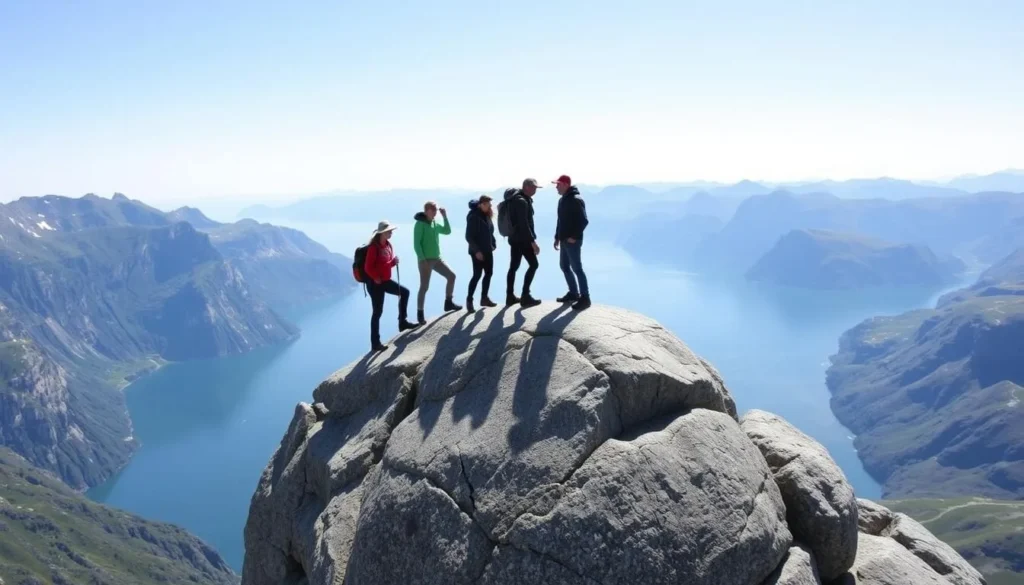
Standing on Kjeragbolten, a rock suspended between two cliff faces, is an experience like no other. This iconic boulder is part of a challenging hike that offers breathtaking views of Lysefjord.
What to Expect on the Hike
The hike to Kjeragbolten is approximately 11 kilometers round trip, with three steep ascents and descents, requiring 6-8 hours to complete. You’ll need good stamina, proper hiking boots, and plenty of water and food supplies. The trail is typically open from June to September, with July and August offering the most reliable weather conditions and the best time to attempt this challenging route.
Throughout the journey, you’ll be treated to spectacular views of Lysefjord, offering some of the most dramatic fjord scenery in Norway. The hike is more challenging than Pulpit Rock, but the scenery and the iconic Kjeragbolten make it a rewarding experience.
Safety Tips
Safety should be your top priority, especially when approaching Kjeragbolten itself. Never attempt to step onto the boulder in wet or windy conditions, and consider your personal comfort with heights before deciding to stand on it. Many hikers find that simply viewing Kjeragbolten and enjoying the surrounding landscape is rewarding enough, without the need to step onto the rock.
Guided tours are available from Stavanger and are recommended for those unfamiliar with Norwegian mountain conditions or hiking alone. These tours provide expert knowledge and additional safety, making your hike more enjoyable and secure.
Cruising the Lysefjord: Spectacular Views from the Water
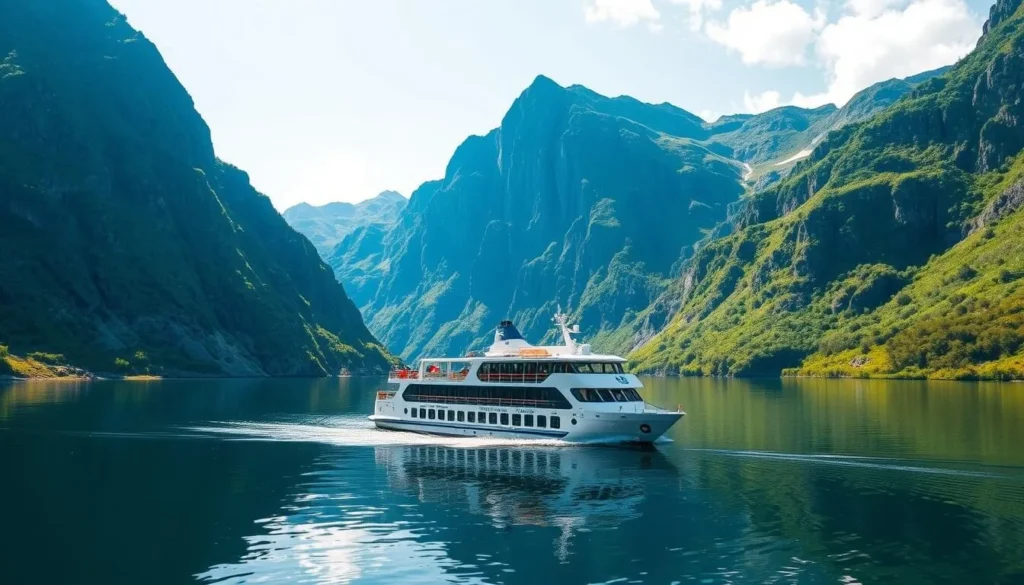
Embark on a tranquil voyage through Lysefjord, surrounded by towering cliffs and cascading waterfalls. If you’re not keen on hiking, a Lysefjord cruise offers a relaxing alternative to experience the majesty of this famous Norwegian fjord. Simply board a boat in Stavanger, sit back, and enjoy the breathtaking views for three hours.
Rødne Fjord Cruise is the company to choose for this experience. They operate three trips daily during the summer months, with fewer trips in the winter, priced at around NOK790 (USD72) per person. The cruise not only offers stunning views of the fjord’s glacially carved landscape but also includes an audio guide with interesting facts about the region.
During your cruise on the water, you’ll witness towering cliff faces, including a unique perspective of Pulpit Rock from below. You’ll also spot cascading waterfalls, abandoned mountain farms, and possibly wildlife like seals and eagles. Most cruise boats feature comfortable indoor seating and outdoor viewing decks, allowing you to enjoy the scenery regardless of the weather.
For the ultimate experience, consider a combination tour that includes both a cruise through Lysefjord and a bus connection to hike Pulpit Rock. This way, you can see this natural wonder from both above and below in a single day. Remember to bring a warm jacket, as it can get chilly on the water, even on sunny days.
Sverd i Fjell: The Iconic Swords in Rock Monument
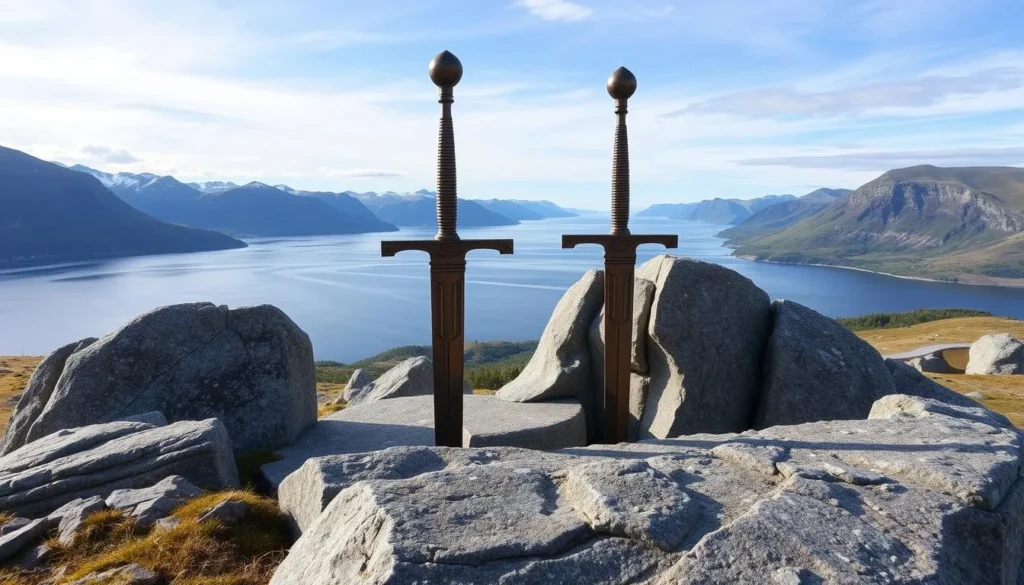
Sverd i Fjell, or ‘Swords in Rock,’ is a striking monument that commemorates a pivotal moment in Norwegian history. Located around 6 km southwest of Stavanger’s city center, this monument is a must-visit attraction. Three massive bronze swords, standing over 33 feet tall, are permanently planted into the rock at Møllebukta bay.
The monument honors the Battle of Hafrsfjord in 872 AD, where King Harald Fairhair united Norway under one kingdom. Created by sculptor Fritz Røed and unveiled in 1983, the swords symbolize peace, unity, and freedom, signifying that they will remain rooted forever.
Visitors can enjoy beautiful views across Hafrsfjord, making it a perfect short excursion from Stavanger. The site is also renowned for its photographic opportunities, especially during sunset when the bronze swords are illuminated by the golden light. You can take a leisurely walk along the shoreline, enjoy a picnic, or simply relax and contemplate this significant historical marker.
By visiting Sverd i Fjell, you connect with Norway’s Viking history and the foundation of the Norwegian nation, making it both an educational and visually striking experience.
Stavanger Cathedral and Religious Heritage
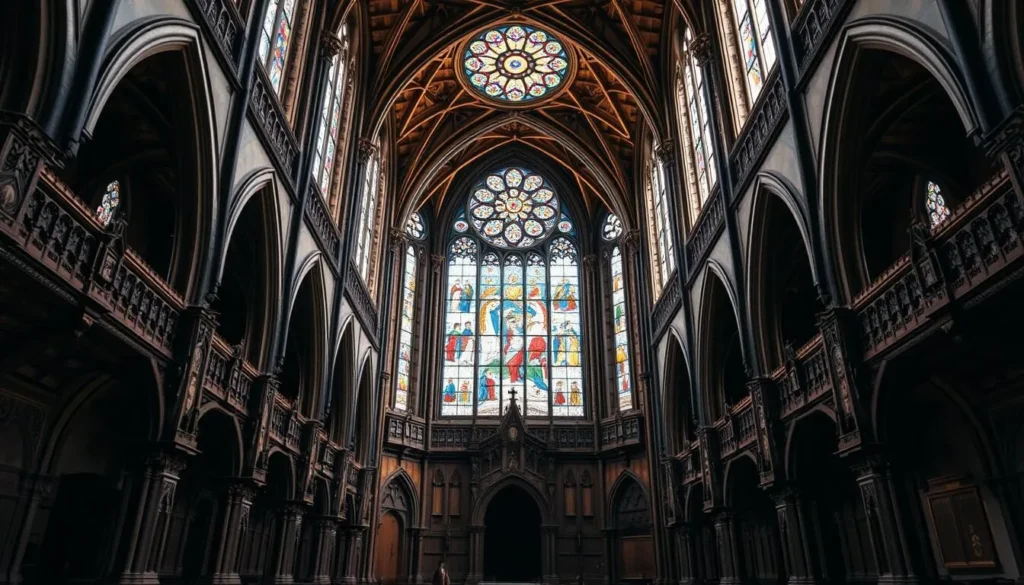
Stavanger Cathedral, Norway’s oldest church still in use, boasts a rich history dating back to 1125. Its architecture is a fascinating blend of Romanesque and Gothic styles, reflecting the medieval craftsmanship of its time. As you step inside, you’ll be transported to a different era, surrounded by intricate woodcarvings and stained glass that create a peaceful atmosphere.
The cathedral’s significance extends beyond its architecture; it’s a testament to the city’s history and the role of religion in shaping Norwegian culture. Despite surviving numerous challenges, including fires and renovations, Stavanger Cathedral remains remarkably intact, offering a glimpse into the past.
Some key highlights of Stavanger Cathedral include:
– Its status as Norway’s oldest cathedral still in continuous use since 1125.
– A unique blend of Romanesque and Gothic architectural styles.
– Well-preserved medieval elements, including woodcarvings and a medieval baptismal font.
– Regular concerts that take advantage of its excellent acoustics.
Visiting Stavanger Cathedral is a must when exploring the city. It provides a moment of tranquility and insight into the history that has shaped this beautiful city over time.
Street Art in Stavanger: A Colorful Urban Gallery

As you wander through Stavanger, you’ll discover a city adorned with street art that reflects its cultural soul. The city’s art scene is a significant part of its identity, making it a fascinating place to explore.
Stavanger has earned international recognition for its vibrant street art scene, transforming ordinary city walls into an impressive open-air gallery that surprises visitors around nearly every corner. The street art legacy began with the Nuart Festival, an annual event that invited world-renowned artists to create large-scale murals throughout Stavanger.
Unlike the temporary nature of art in many cities, Stavanger’s murals are largely preserved and protected, creating a permanent collection that spans various artistic styles. Walking through Stavanger, you’ll encounter thought-provoking pieces that often comment on social issues, politics, and environmental concerns, reflecting the progressive values of Norwegian society.
The contrast between these modern art expressions and Stavanger’s traditional wooden architecture creates a fascinating visual dialogue between the city’s past and present. Some of the most impressive murals can be found in the Østre bydel (Eastern district) of Stavanger, though significant works are scattered throughout the city center as well.
For the full experience, consider downloading a street art map or joining a guided tour that provides context about the artists and the stories behind their creations. This adds another dimension to Stavanger’s cultural landscape, demonstrating how this historic city continues to embrace contemporary artistic expression.
Culinary Experiences: Tasting Stavanger’s Food Scene
Stavanger offers a unique culinary experience that blends traditional Norwegian cuisine with modern twists. Visitors can enjoy a variety of local dishes and drinks that reflect the country’s rich cultural heritage.
Traditional Norwegian Dishes
Norwegian cuisine is known for its simplicity and heartiness, often featuring local ingredients. Must-try dishes include Fiskesuppe (fish soup), Fårikål (mutton stew), and Kjøttkaker (Norwegian meatballs). Don’t miss Brunost, a caramelized cheese that’s a staple.
Top Restaurants and Cafes
Stavanger is home to several top-notch restaurants and cafes. Fisketorget serves fresh seafood, while RE-NA offers fine dining with local ingredients. Visitors can also enjoy traditional Norwegian pastries and sandwiches at local cafes.
Day Trips from Stavanger: Exploring the Region
You can enjoy a range of exciting day trips from Stavanger, each offering a unique experience. The region surrounding Stavanger is rich in diverse landscapes and attractions, making it an ideal location for exploring.
Flor & Fjære Garden Island
Flor & Fjære is a tropical paradise located just 20 minutes by boat from Stavanger. This lush garden island boasts a unique microclimate, sheltered from the wind, allowing for the growth of exotic plants and palm trees. The garden features over 50,000 flowers planted every spring, accompanied by a guided tour and a gourmet meal in their greenhouse restaurant.
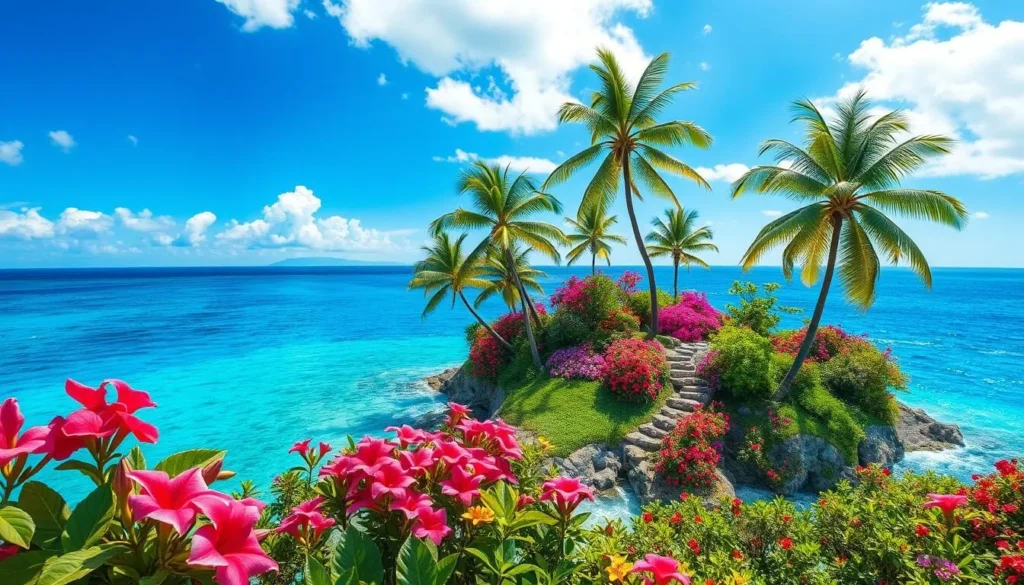
Beaches of Jæren
For a completely different landscape, head to the beaches of Jæren, where miles of sandy shoreline stretch along the North Sea coast. Sola Beach, just 15 minutes by car from Stavanger, is the most accessible beach area, featuring fine white sand. It’s perfect for surfing, beach walks, and capturing dramatic photographs.
Ryfylke Scenic Route
The Ryfylke Scenic Route is one of Norway’s most beautiful drives, winding through mountains, alongside fjords, and past charming villages. This route is ideal for those who have rented a car and want to explore beyond Stavanger. Along the way, you’ll find numerous stopping points for short hikes, picturesque viewpoints, and local craft shops selling traditional Norwegian products.
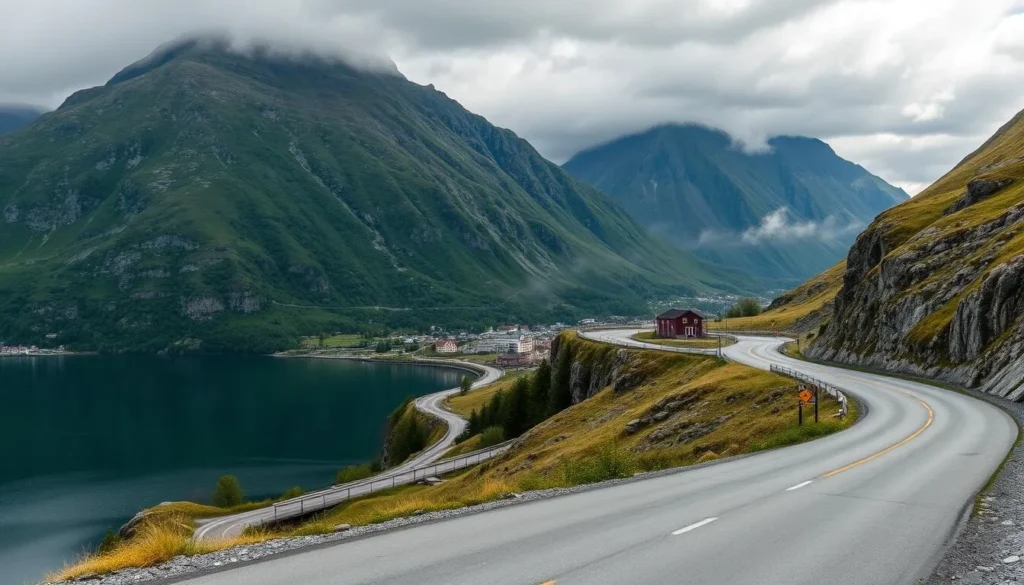
These day trips from Stavanger showcase the incredible diversity of landscapes within the region, from cultivated gardens to wild coastlines and mountain terrain, all accessible within a short distance from the city. Whether you’re looking for a relaxing day out or an adventurous trip, Stavanger has something to offer.
Conclusion: Making the Most of Your Stavanger Visit
When visiting Stavanger, you’ll discover a city that seamlessly blends tradition with modern adventure. To truly experience all that Stavanger has to offer, plan to spend at least 3-4 days in the city, allowing time for both urban exploration and at least one of the iconic hikes in the surrounding region.
The summer months (June to August) are the best time to visit Stavanger, with long daylight hours and optimal hiking conditions. Consider structuring your visit with city-based activities for days when weather forecasts aren’t favorable for hiking, keeping your outdoor adventures flexible.
While Stavanger can be enjoyed on a budget, setting aside funds for at least one special experience—whether a fjord cruise, a fine dining meal, or a guided adventure—will enhance your appreciation of the region. Don’t rush through Stavanger as merely a gateway to Pulpit Rock; the city itself deserves your attention with its museums, historic districts, and vibrant cultural scene.
Stavanger offers a perfect blend of natural wonders and urban comforts, making it an ideal destination for travelers who want to experience authentic Norway without sacrificing conveniences. Whether you’re drawn by the thrill of standing atop Pulpit Rock or the charm of wandering through Gamle Stavanger, Stavanger rewards visitors with unforgettable experiences.
—
The above is subject to change.
Check back often to TRAVEL.COM for the latest travel tips and deals.
